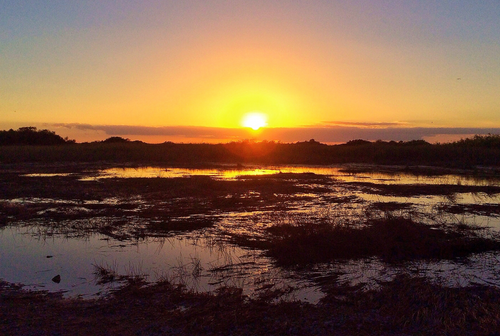Houston residents are witnessing one of nature's most spectacular annual displays as a massive Saharan dust cloud transforms the city's sunsets into vibrant Technicolor shows. The dust plume, which arrived on June 29, creates breathtaking red, orange, and yellow skies while simultaneously introducing fine particulate matter that poses significant health risks for millions of residents, particularly those with respiratory conditions or cardiovascular sensitivities.
This meteorological phenomenon, caused by the 2.5-mile-thick Saharan Air Layer associated with warmth, dryness, and strong winds, demonstrates how natural events can dramatically affect local air quality in ways that require immediate health protection strategies. For health-conscious individuals, Houston's current Saharan dust event illustrates the importance of understanding how even beautiful natural phenomena can create hidden health threats that demand proactive indoor air protection.
The Science Behind Saharan Dust Transport
The Saharan Air Layer represents one of the world's most impressive atmospheric transport systems, carrying fine desert particles across thousands of miles from North Africa to the Gulf Coast. According to the National Environmental Satellite, Data, and Information Service, this annual phenomenon affects weather patterns across the Atlantic, including the intensity of tropical cyclones and local atmospheric conditions.
The dust particles responsible for Houston's spectacular sunsets are the same microscopic contaminants that can trigger serious health problems for sensitive individuals. These fine particulates, similar in size and health impact to industrial pollution, can penetrate deep into lung tissue and enter the bloodstream where they trigger inflammatory responses throughout the body.
ABC13 meteorologist Travis Herzog's documentation of the dust cloud reveals the massive scale of this atmospheric event, which can affect air quality across entire metropolitan areas for days or weeks.
The visual beauty of enhanced sunsets occurs through the same light-scattering process that creates health risks. As sunlight passes through dust-laden atmosphere, particles scatter shorter wavelengths while allowing longer red and orange wavelengths to reach viewers, creating spectacular displays that mask the underlying air quality threats.
Health Impacts of Natural Dust Events
The fine particulate matter in Saharan dust can trigger immediate health symptoms in sensitive individuals, including sneezing, coughing, scratchy throat, and shortness of breath. However, research reveals that the health impacts extend beyond obvious respiratory symptoms to include cardiovascular effects that can affect even apparently healthy individuals.
Some studies have linked Saharan dust exposure to increased cardiovascular mortality risk, suggesting that these natural pollution events can trigger heart attacks, strokes, and other cardiovascular emergencies in susceptible individuals. The inflammatory responses triggered by breathing fine dust particles affect blood vessel function, blood clotting mechanisms, and heart rhythm regulation in ways that can persist long after dust levels return to normal.
The National Oceanic and Atmospheric Administration (NOAA) recommends that people with underlying health conditions stay indoors during dust events, but this guidance may not provide adequate protection since standard residential ventilation systems cannot filter the ultrafine particles that pose the greatest health risks.
The Air Oasis commitment to comprehensive air protection becomes particularly important during natural dust events like Houston's current Saharan dust episode, when outdoor air quality can deteriorate rapidly while residents may be unaware of the health risks hidden behind beautiful sunset displays.
The Paradox of Natural Beauty and Health Risk
Houston's Saharan dust event creates a fascinating paradox where one of nature's most beautiful displays coincides with significant air quality degradation. The same particles that create Instagram-worthy sunsets can trigger asthma attacks, cardiovascular stress, and respiratory inflammation that affects daily health and wellness outcomes.
This contradiction highlights an important principle for health-conscious individuals: environmental beauty doesn't guarantee environmental safety. Natural phenomena can create health threats that rival or exceed those from industrial pollution, making it essential to evaluate air quality based on scientific measurements rather than visual appearance.
The dust particles enhance sunset colors by scattering light in the same way that urban smog creates spectacular sunrises and sunsets in polluted cities. The visual appeal of these atmospheric displays can mask the underlying health risks, creating situations where people may increase their exposure to harmful pollutants while trying to enjoy natural beauty.
NOAA's forecast that this year's dust cloud will bring only "light concentrations with no major impacts on visibility" demonstrates how natural dust events can affect health even when they don't create obvious visibility problems. The particles most dangerous to human health are often too small to see individually, making air quality monitoring more important than visual assessment.
Temperature and Weather Complications
Saharan dust events create additional health challenges by affecting local weather patterns in ways that can intensify heat exposure and reduce natural cooling mechanisms. NOAA explains that dust clouds can "stifle cooling afternoon thunderstorms," potentially creating some of the hottest days of the year when residents most need relief from outdoor heat.
This combination of poor air quality and extreme heat creates compound health risks that exceed the dangers of either condition alone. Heat stress impairs the body's ability to filter and process airborne contaminants, while air pollution reduces the respiratory efficiency needed for effective temperature regulation.
The timing of Saharan dust events during Houston's summer months creates particularly challenging conditions for outdoor workers, athletes, and others who cannot easily avoid exposure to both heat and air pollution simultaneously. The iAdaptAir technology from Air Oasis provides crucial protection during these compound environmental threats by creating clean, cool indoor environments that support recovery from both heat and pollution exposure.
Enjoying Beauty While Protecting Health
Houston residents don't need to choose between enjoying spectacular sunsets and protecting their health from Saharan dust exposure. The key lies in understanding that natural beauty and environmental health threats can coexist, requiring strategies that allow appreciation of atmospheric phenomena while maintaining clean indoor breathing environments.
NOAA's recommendation to enjoy "vibrant red, orange, and yellow skies" from the "comfort of air conditioning" reflects the reality that indoor protection strategies allow participation in natural events without accepting unnecessary health risks. Advanced air purification systems can maintain indoor air quality that measures significantly better than outdoor conditions during dust events, allowing residents to enjoy spectacular sunsets through windows while breathing clean air.
The expected dissipation of this year's dust cloud by the end of the week provides a timeline for current protection needs, but Saharan dust events occur annually during summer months, making them recurring health challenges that require ongoing protection strategies rather than temporary responses.
Preparing for Recurring Natural Air Quality Events
Houston's Saharan dust experience demonstrates why health optimization requires preparation for recurring natural phenomena that can affect air quality and health outcomes. While these events are predictable in general timing, their specific intensity and duration can vary significantly, making proactive protection strategies more effective than reactive responses.
The lesson from Houston's current dust event is that natural environmental phenomena can create health challenges that require the same level of protection as industrial pollution events. Taking control of your indoor air quality provides benefits during current dust events while preparing for future natural and human-caused air quality challenges.
Your health optimization journey should account for the full range of environmental factors that can affect wellness outcomes, including natural phenomena that create temporary but significant health risks. Rather than hoping for perfect outdoor conditions, comprehensive indoor air purification provides consistent protection that allows you to enjoy natural beauty while maintaining optimal health. Shop Air Oasis today and ensure that your wellness goals remain protected during Houston's spectacular but challenging Saharan dust events.




